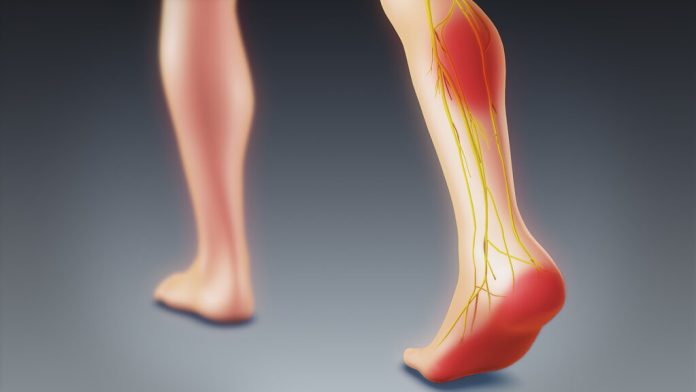Can sciatica be a cause or pain in your feet?
Many patients experience pain on the outer side of their foot due to a pressed nerve root in the spine. This is known as classic sciatica. This type of sciatica affects only one nerve root, the S1; pain along the foot’s outer side usually relates to the level of the disc and the associated nerve root. Pain in the top or bottom of the foot, however, may be due to a compressed nerve root. This article will explore the causes of nerve root irritation and sciatica signs.
What does foot pain from sciatica feel like?
Sciatica can cause burning, numbness, or tingling, typically occurring on only one side. Other sciatica symptoms include weak or uncontrollable muscles, difficulty bending or straightening the knee or difficulty pointing toes. Listed below are some of the common symptoms of sciatica.
Foot pain caused by sciatica can be related to the back or originate from a problem elsewhere in the body. The pain originates in the lumbar region of the lower back and radiates down the leg. Because nerve roots can be located all over the body, irritating these nerves can cause pain radiating to the foot. Symptoms of sciatica vary from person to person.
A doctor will conduct a physical examination. In addition to examining the foot, the doctor will look for other signs of sciatica, such as numbness or weakness in the foot. Physical exam results will determine the exact location of the sciatic nerve and what treatments will be most effective. Treatment will depend on the cause of the pain and may include physiotherapy or a combination of both.
What part of the foot hurts with sciatica pain?
If you suffer back pain, you might have wondered what part of the foot hurts with sciatic nerve pain. The pain in your lower back may radiate to your foot and ankle. However, that is not always the case. The pain may be due to a fracture, infection, or a debilitating back condition. So, it would be best if you visited a spine doctor to determine whether sciatica is the cause of your foot pain.
Sciatica pain is characterized by a burning or tingling sensation in the leg, a dull ache, or numbness in other body parts. It most often affects one leg but may also radiate to the toes. Some causes of the pain are mechanical, such as a herniated disk, an overgrowth of bone on the vertebrae, or an infection of the sciatic nerve. If you suspect a disc or another medical problem is the culprit, your doctor will recommend treatment for the cause and help you recover from the pain.
In most cases, sciatic pain is caused by a problem with the sciatic nerve. This nerve starts in the back, runs down the leg, and ends in the foot. A slipped disc can press on the sciatic nerve root, causing pain in the foot. Herniated discs result in the disc’s inner core being forced out of the spine and putting pressure on the sciatic nerve.
How do I get rid of sciatic nerve pain in my foot?
First, icing is a good way to decrease inflammation and help reduce pain. Ice the affected area for 20 minutes on and 20 minutes off. Repeat the process two to three times daily. Also, you can try standing stretches. Make sure your feet are at least 24 inches from a wall when doing these stretches. Avoid standing on the affected foot or ankle. Try to maintain good posture and avoid sitting for long periods.
Alternating heat and cold treatments may help relieve the discomfort caused by sciatica. While ice reduces inflammation, heat encourages blood flow to the affected area, which speeds up healing. Both methods are useful for relieving pain from sciatica, but you must be sure to follow directions carefully. It would be best if you alternated hot and cold applications every two to three hours and always used a barrier. Never sleep while using heat or ice.
If you experience sciatic nerve pain in your foot, it may be a sign of other problems. The most common cause of pain in the foot is a slipped disc. When the disc presses on the nerve root, it can cause a range of pain symptoms, including tingling between the toes and pins-and-needles on the side of the foot. Other causes may be a bone condition or a tumour. Nevertheless, seeking medical advice is important if you are experiencing sciatica symptoms.
How does sciatica affect the spinal cord?
The most common treatment for sciatica involves activity modification and pain medication. Doctors typically prescribe NSAIDs (nonsteroidal anti-inflammatory drugs), acetaminophen, and muscle relaxants. In severe cases, spinal decompression surgery may be recommended. The nonsurgical treatment is more conservative than the surgical approach but can still help the patient overcome the pain. NSAIDs and muscle relaxants are generally effective for mild to moderate sciatica.
A herniated disc presses against the sciatic nerve. This pressure may lead to sciatica. However, this condition is not life-threatening and will usually heal on its own with rest and time. However, if the sciatic nerve is compressed, you should see a physician immediately. A herniated disc can result in nerve compression. In some cases, an abnormally shaped vertebra may also compress the sciatic nerve.
A CT scan may be required to determine the cause of sciatica. This imaging test uses radio waves or magnetic fields to produce images of bones and soft tissues in the spine. A CT scan will give a clearer picture of the spinal column and discs. An MRI may also be required to determine if a disc has herniated or become compressed. Various treatments are available to ease sciatic pain.
Can sciatica affect your feet?
The sciatic nerve is located in the lower back and travels down the legs, terminating in the feet. If the nerve is irritated, pressed, or pinched, the result is foot pain. The pain is sharp, akin to a pin or needle, and often accompanies other symptoms in the lower back.
There are several common causes of sciatica, but the main cause is usually a slipped disc or spinal vertebra. Disc impingement causes the nerve root to be compressed and irritated. Symptoms can range from mild tingling and numbness to extreme pain and weakness in the affected leg. In severe cases, the pain can radiate down the foot, making it hard to walk or even stand.
Other causes of sciatica include osteoarthritis or pregnancy. Osteoarthritis, for example, damages the spinal disk and puts the nerve at risk. An inactive lifestyle also increases the risk. Lastly, smoking increases the risk of sciatica by weakening the bones and accelerating the wear and tear of vertebral discs. It’s not just pregnant women at risk for sciatica – men and athletes can develop the condition.
What are the four types of sciatica?
While there are several causes of sciatica, the four most common include a spinal cord condition, nerve irritation, and recent injuries. The severity of your symptoms depends on the underlying condition, but some are common across all types of sciatica. To diagnose properly, your doctor will perform a physical examination and examine your muscles, joints, and ligaments. Nerve tests can detect abnormalities in the sciatic nerve and determine the exact location and degree of pain. Imaging tests are also helpful in determining the exact cause of sciatica.
Neurogenic sciatica is caused by compression of the sciatic nerve or smaller nerve roots. The type of pressure applied to the nerve will determine the severity of the symptoms. Nerve compression is a common cause of sciatica and can be caused by tight muscles or bulging discs. Discs between the vertebrae become weak and susceptible to injury, and a herniated disc puts direct pressure on the sciatic nerve. Discs are also susceptible to degenerative disc disease, which causes them to break down. The soft inner nucleus pulposus can rupture and push on the sciatic nerve.
The most common type of sciatica is lumbar sciatica. This condition affects the nerves in the lower part of the cord in the spine and needs immediate medical attention. Other types of sciatica include piriformis syndrome, cauda equina syndrome, and lumbar spinal stenosis. Fortunately, sciatica is not life-threatening unless you have immediate medical attention.
How long does it take for a sciatic nerve to heal?
About 40% of adults will suffer from sciatica at some point. The pain, which radiates down the back of one leg, comes from compression or irritation of the sciatic nerve. The nerve is the largest in the body, exiting the spinal column near the base. The sciatic nerve splits into two branches, one running down the leg and the other down the other. Inflammation of the sciatic nerve can occur in either branch or both.
Some conditions can cause sciatica pain, including bone spurs, spinal stenosis, and tumors. Even though many people assume that lifting something causes pain, many other causes exist. A disc can also press on a nearby nerve, resulting in sciatica. Typically, herniated discs heal independently, but in some cases, they cause chronic pain. Other reasons can contribute to the ongoing pain in the back: aging, genetics, and lifestyle habits.
Depending on the severity of sciatica, the recovery time can be anywhere from four to eight weeks. For most people, the pain is temporary and goes away in four to six weeks. If the pain persists beyond this timeframe, you may need to see a doctor determine what to do next. If the pain lasts longer than six weeks, it’s likely to be chronic.
Conclusion
As your feet are such complex structures, there are many potential causes of foot pain, and sometimes the cause lies somewhere other than the foot itself. Foot pain is an affliction that affects almost everybody at some point in their lives. While most of the time it is caused by some outside disturbance (such as ill-fitting shoes) or a problem within the foot itself, sometimes a completely different body part causes pain. It would be best if you found out the specific cause of your foot pain. Other non-spinal issues can cause foot pain. Plantar fasciitis could also be the culprit of foot pain.
Other sciatica signs include pins and needles in your foot or leg, numbness, and muscle weakness. In some cases, it causes numbness or muscle weakness in an area of your leg on one side of your body. Sciatica can also be caused by sciatic nerve compression in the buttocks or leg.

Doctor Osvaldo Pepa, Neurosurgery Service Physician at Hospital San Martin, La Plata, Argentina. I graduated last November 16, 1984 with a Medical Degree at the Universidad Nacional de La Plata. The Medical Board of La Plata, District 1, licensed me as a Neurosurgeon in 1990. I hold a Provincial and National License and an active member of the Neurosurgery Society of La Plata, World Ozone Therapy Federation, and Inter American Society of Minimally Invasive Surgery.
